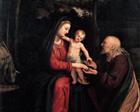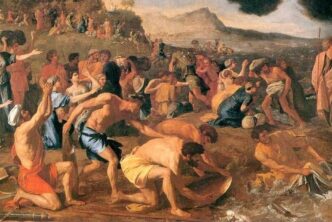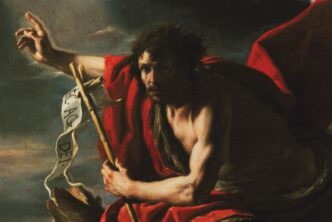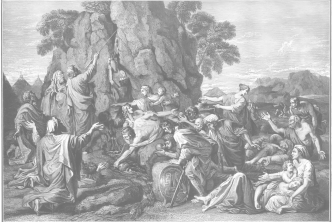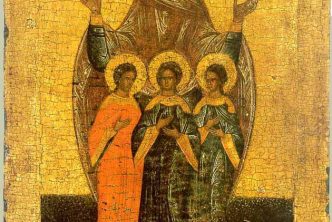This guest post is by Verbum Director Kevin Bagley, D Min.
Be sure to see our Verbum Monthly Sale for special savings on resources about St. Joseph!
Of the members of the Holy Family, we know the least about Joseph. His appearance in Scripture is brief, and not a single word in Scripture is attributed to him. He appears in three of the Gospels, and what little else we know has been handed down through tradition and the few writings about him from the early writings of the Church, including The Gospel of Pseudo-Matthew, The Gospel of James, The Gospel of the Nativity of the Virgin Mary, and The Ante-Nicean Fathers.
One tradition holds that Joseph lived to be 111 years of age. As a younger man, he had served as a priest in the temple. When we meet Joseph in scripture, he is a tekton (Mt. 13:55; Mk 6:3), translated as mechanic; more specifically, a carpenter. Wood might not have been his only medium, as stone is also prevalent in the area. His wife preceded him in death and together they had six children (Judas, Justus, James, Simon, Assia and Lydia). Joseph took Mary into his home and cared for her and the child Jesus after being selected as her husband.
Mary was the daughter of the aged Joachim and Anna. When Mary was three years old, Joachim and Anna brought her from their home in Bethlehem to the temple in Jerusalem to consecrate and devote her to the service of the Lord. Early church tradition holds that Mary made a vow of virginity.
According to the prophecy of Isaiah (Is. 11:1-2), a man should be sought to whom the virgin should be entrusted and espoused. Staffs were to be collected from each of the unmarried men of the house and family of David and kept overnight in the holy of holies of God’s temple. It was believed that the man’s staff, from which a dove appeared, would be the man to care for Mary. The following morning, all the staffs except Joseph’s were brought out of the temple. When no dove appeared from any of the staffs, another attempt was made. The second attempt at finding a spouse for Mary ended as the first. The high priest realized that Joseph’s staff had not been brought forth with the others. Joseph’s staff was retrieved and handed to him. Upon receiving the staff, a dove appeared from the staff and flew toward Heaven. God’s will was clear: Mary would be entrusted and espoused to Joseph. One tradition describes Joseph asking why he was being asked to take Mary into his home, as she was younger than some of his grandsons. But wishing to do the work of the Lord, Joseph received Mary into his care.
Joseph returned to Nazareth to make things ready for his spouse. He then returned to his trade, one that took him away from home for an extended time. He may have been building homes by the shore, or perhaps he was at work on the temple. When Joseph returned home, after several months away, he found that Mary was pregnant. Joseph, deeply troubled by this information, considered sending her away secretly. As he pondered what action to take, the angel of the Lord appeared to him in a dream, informing him that it was an act of the Holy Spirit that Mary had conceived. The angel further instructed Joseph to name the child Jesus, because he would save the people from their sins (Mt. 1:18-22).
At that time, Caesar Augustus decreed that a census be taken of the entire world. This meant that Joseph and pregnant Mary had to travel to Bethlehem, his ancestral home (Lk. 2:1-5). As many people had descended upon Bethlehem for the census, there were no suitable accommodations. Joseph, doing the best he could, found a warm stable where Mary could give birth (Lk. 2:7). Just days after the birth, the family was greeted by local shepherds who came to visit the Messiah (Lk. 2:16).
According to Jewish law, Joseph and Mary took Jesus up to the temple in Jerusalem to present Jesus to the Lord (Lk. 2:22), where they were greeted by Simeon, who had been waiting all his life to see the Messiah.
Joseph had settled the family in a house in Bethlehem when the Magi came to visit (Mt 2:11). After the Magi departed, Joseph was warned in a dream that they must flee to Egypt, as King Herod intended to destroy the child (Mt. 2:13). Joseph did as he was told, remaining in Egypt until the death of King Herod (Mt. 2:14-15). An angel once again spoke to Joseph in a dream, telling him it was safe to return home. Fearing the wrath of Herod’s son Archelaus, Joseph did not return to Bethlehem but rather chose to settle the family in Nazareth (Mt. 3:19-23).
The last image we have of Joseph in scripture is when the family traveled to Jerusalem for Passover. Journeying in caravans, the men walked in one group and the women and children walked in another. At the age of twelve, Jesus was old enough to travel with the men, and yet still young enough to be with the children. Both parents thought Jesus was with the other, until they met in the evening for rest—to find Jesus missing. Frantic with anxiety, they quickly returned to Jerusalem and spent three days searching for their son. They found him on the third day, sitting in the midst of the teachers in the temple. They returned home to Nazareth to raise their son (Lk. 41-52).
As a young boy, the only human father Jesus knew was Joseph. Joseph was father, provider, teacher, mentor, and role model for his son. Pressed into service as an old man, Joseph cared for his wife and son, endured the hardship of fleeing persecution from the government with his infant child, provided a home for his family, and taught his son a noble trade.

